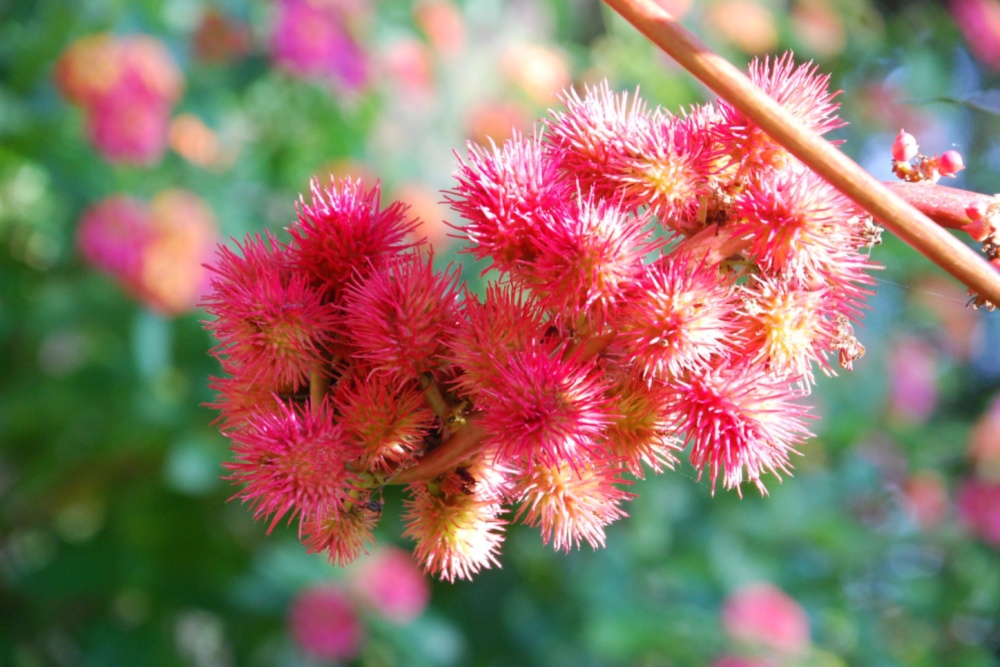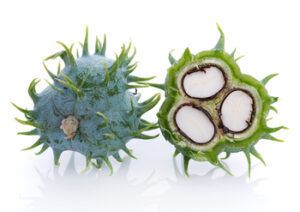What's On This Page?
ToggleFor generations, castor oil packs have been a well-kept secret for easing various types of pain and discomfort. Their resurgence as a natural and holistic remedy offers a gentle yet effective alternative to the usual over-the-counter pain medications. If you’re curious about how this traditional therapy can enhance your well-being, you’ve come to the right place.
This time-tested remedy has indeed worked wonders for many, providing relief without the drawbacks of pharmaceuticals. Let’s explore the versatile uses of castor oil packs and how you can safely incorporate them into your self-care routine because they are a more ‘comfy’ alternative to pain meds! No side effects!
Castor oil, derived from the seeds of the Ricinus communis plant, has been valued since ancient times. Its healing properties are due, in part, to its rich content of ricinoleic acid—a type of FATTY ACID known for its anti-inflammatory and analgesic effects. Look how beautiful the flowers are too!

A Versatile Solution for Various Ailments
While castor oil packs are a favorite for menstrual cramps and fibroid pain, their application extends far beyond. Here’s how they can help with a range of issues:
- Digestive Disorders: The application over the abdomen may aid in relieving constipation, soothing IBS, and supporting liver and gallbladder health.
- Inflammatory Conditions: Their anti-inflammatory properties can be a boon for those with joint pain, ligament strains, or inflammatory bowel diseases.
- Skin Problems: Castor oil’s antimicrobial and antifungal benefits make it useful for addressing skin conditions like keratosis and ringworm.
- Menstrual Cramps: Castor oil is comforting, and soothes pelvic cramping. You may be interested in reading about something else that helps cramps: Cramp Bark Eases Vexing Stomach Aches And Monthly Cramps.
How to Use Castor Oil Packs Safely
Regular use of castor oil packs is generally safe, provided you follow these guidelines:
- Consult with Your Doctor: Especially if you have specific medical conditions, it’s important to ensure that increased blood flow won’t be problematic.
- External Use: I echo the consensus that castor oil should primarily be used externally. It’s potent and can cause adverse effects if ingested improperly.
- Application Technique: Place the pack over the area in pain, such as the abdomen or back, and add heat to enhance its soothing properties.
Creating Your Own Castor Oil Pack
You’ll need a few simple supplies—castor oil, a wool cloth, plastic wrap, a towel, and a hot water bottle. Follow these steps:
- Soak the wool cloth in castor oil.
- Heat the cloth gently (a microwave works, but be cautious of the heat).
- Apply the cloth to the affected area, cover with plastic wrap, and then a towel.
- Place a hot water bottle on top to maintain warmth.
- Relax with the pack for about 30 minutes to an hour.
- Repeat several times a week as needed.
Clean-Up Tip: Removing the oiliness from your skin afterward is easy with a baking soda and water paste.

From Castor Beans to Castor Oil: How It’s Made
Imagine you’re a college student majoring in “Castor Oil Production 101.” Here’s how the magic happens, from plant to bottle:
- Harvest Time: Farmers harvest castor beans when they’re ripe. These aren’t the kind of beans you’d eat; they’re the seeds from the castor plant, Ricinus communis, which is kind of like the black sheep of the bean family because some parts of it are toxic if you eat them.
- Drying and Shelling: Once harvested, the beans need to dry out so that they can be easily cracked open to get the seeds inside. It’s like getting to the good part of a sunflower seed, minus the tasty snack part.
- Cleaning Up: The seeds are cleaned to get rid of dirt, leaves, or anything else that hitched a ride from the field. Think of it as prepping your ingredients before you cook.
- Pressing for Oil: The clean seeds are pressed, which squishes out the oil. It’s like squeezing an orange for juice, but with way more pressure. This method is called “cold pressing” and it keeps the good stuff in the oil without using heat or chemicals.
- Purifying: The oil that comes out isn’t ready for the shelf yet. It’s got some impurities that need to be removed. So, it’s filtered to clean it up, sort of like straining pasta after you cook it.
- Bottling: Once the oil is nice and pure, it’s bottled up. This is the stuff you see on the shelves at stores. It’s ready to be used for your skin, hair, or in a castor oil pack for those cramps.
- Testing: Before the oil hits the stores, it goes through some quality control tests. This is like the final exam, making sure the oil makes the grade.
And there you go! You’ve just followed the journey of castor beans turning into the castor oil you find in stores, ready to be used for all its awesome benefits.
As always, remember that self-care is a personal journey, and what works for one may not work for another. If you decide to try castor oil packs, listen to your body’s response, and consult your healthcare provider for personalized advice. In the realm of natural health, sometimes the oldest tricks are the best kept.

Suzy Cohen, has been a licensed pharmacist for over 30 years and believes the best approach to chronic illness is a combination of natural medicine and conventional. She founded her own dietary supplement company specializing in custom-formulas, some of which have patents. With a special focus on functional medicine, thyroid health and drug nutrient depletion, Suzy is the author of several related books including Thyroid Healthy, Drug Muggers, Diabetes Without Drugs, and a nationally syndicated column.
